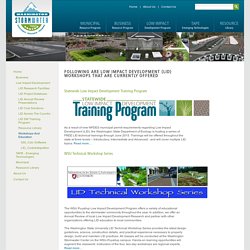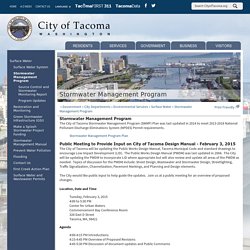

Report - Surface Water Health. Pierce County, WA. Stormwater retrofit planning project for Green River Watershed - King County. Juanita Creek stormwater retrofit. The Stormwater Retrofit Analysis and Recommendations for Juanita Creek Basin in the Lake Washington Watershed focuses on a tributary stream to Lake Washington covering the City of Kirkland.

The publication identifies a retrofit strategy or strategies that would meet the project goal -- improving flow and water quality to support aquatic life, including use by fish. As of 2012, Juanita Creek basin is nearly 70% developed with stormwater facilities that are critically lacking or undersized relative to current stormwater standards.
The best performing mitigation scenario combined the flow control standards for low-flow (low impact development (LID) performance standard) and high-flow (standard requirement) proposed by Ecology in the draft Phase 1 Municipal National Pollutant Discharge Elimination System (NPDES) permit with effective date of August 1, 2013. Download the report Full document (16.4 Mb) Washington Stormwater Center. Dispersion attempts to minimize the hydrologic changes created by impervious surfaces by restoring the natural drainage patterns of sheet flow and infiltration.

Chapter 6 of the 2004 SWMMEW provides design guidance for three types of dispersion BMPs, including: Concentrated Flow Dispersion (BMP F6.40). Sheet Flow Dispersion (BMP F6.41). Full Dispersion (BMP F6.42). Dispersion is generally cost-effective for projects with sufficient space available on-site, because limited infrastructure needs to be installed and maintained. In some situations, where infiltration is feasible and setback requirements can be met, dispersion may provide adequate runoff treatment and flow control to partially or fully satisfy Ecology’s Core Elements #5 and #6. Sheet Flow Dispersion (BMP F6.41)Sheet flow dispersion is among the simplest methods for runoff control.
Designs incorporating full dispersion in accordance with BMP F6.42 in the 2004 SWMMEW do not typically require additional runoff control. Roof Downspout Controls. LID Implementation Advisory Committee. Eastern Washington Phase II Municipal Stormwater Permit. Low Impact Development. Bioretention Factsheet. Kitsap County, Washington. LID Guidance Manual. Washington Stormwater Center. Following are Low Impact Development (LID) Workshops that are currently offered Statewide Low Impact Development Training Program As a result of new NPDES municipal permit requirements regarding Low Impact Development (LID), the Washington State Department of Ecology is hosting a series of FREE LID technical trainings through June 2015.

Trainings will be offered throughout the state at three levels – Introductory, Intermediate and Advanced - and will cover multiple LID topics. Read more… WSU Technical Workshop Series The WSU Puyallup Low Impact Development Program offers a variety of educational opportunities to the stormwater community throughout the year. The Washington State University LID Technical Workshop Series provides the latest design guidelines, science, construction details, and practical experience necessary to properly design, build and maintain LID practices. LID Code Update and Integration Training NEW! Register here: NEW! This webinar provides: Videos for Elected Officials. HBA LID Showcase (Video) Monday 12.3 After Record Setting Rainfall. Phytoremediation Pollutant Removal. Soil bioretention protects juvenile salmon and their prey from the toxic impacts of urban stormwater runoff. The Woods at Golden Given. The Woods at Golden Given. The Woods Site Plan Color.
City of Tacoma Stormwater Management Manual Updates. Stormwater Management Program. Stormwater Management Program The City of Tacoma Stormwater Management Program (SWMP) Plan was last updated in 2014 to meet 2013-2018 National Pollutant Discharge Eliminations System (NPDES) Permit requirements.

Public Meeting to Provide Input on City of Tacoma Design Manual - February 3, 2015 The City of Tacoma will be updating the Public Works Design Manual, Tacoma Municipal Code and standard drawings to encourage Low Impact Development (LID). The Public Works Design Manual (PWDM) was last updated in 2004. The City will be updating the PWDM to incorporate LID where appropriate but will also review and update all areas of the PWDM as needed. The City would like public input to help guide the updates. Location, Date and Time Agenda The City encourages all interested parties to attend this public meeting. Public comments may be submitted in writing to swmupdates@cityoftacoma.org until February 18, 2015. Portfolio. Sehmel Homestead Park is home to a wide variety of recreational, educational, and cultural activities.

Through an extensive public involvement process with an extremely involved community, AHBL was able to design the park to meet the needs of the area. Amenities include all-weather soccer/football fields, softball fields, baseball fields, tennis courts, a basketball court, a playground, community gardens, picnic areas, outdoor amphitheater, a multipurpose pavilion, and a picnic meadow.
Because of the site's location in a rural overlay district, we were required to utilize the Low Impact Development Chapter of the Pierce County Stormwater Management and Site Development Manual. This was the first major project designed under this newly adopted chapter. AHBL's civil engineers employed a variety of techniques to sustainably manage stormwater.
The environmental permitting work involved preparing documentation for SEPA environmental review.